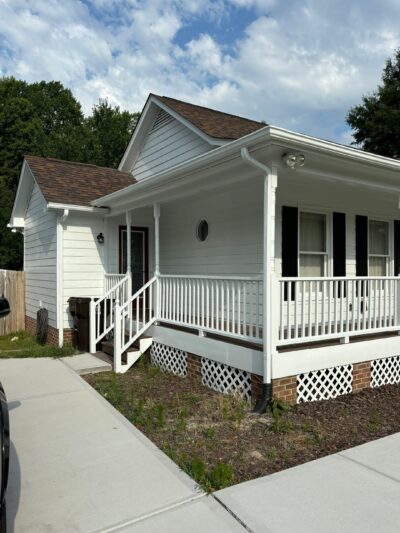When planning an exterior house painting project, knowing the right time to repaint can save you money and protect your home’s value. Keeping an eye out for the signs to repaint your house exterior helps you maintain a fresh, durable look while guarding against damage from weather and wear. The exterior paint doesn’t just add curb appeal—it’s a shield against the elements. Ignoring these signs could lead to costly repairs down the road.
Before we jump into the specific signs to repaint your house exterior, let’s explore why timely repainting matters and how it benefits your home in the long run.
Key Takeaways:
- Fading or dull paint color signals UV damage and loss of protection.
- Peeling or cracking paint means moisture has penetrated, risking wood damage.
- Chalking residue indicates paint binder failure and reduced durability.
- Mold, mildew, and stains harm appearance and can damage surfaces.
- Rising energy bills and drafts can result from worn exterior paint and gaps.

Signs to Repaint Your House Exterior
Painting your house exterior is more than a cosmetic choice. The paint acts as a barrier, defending wood, siding, and masonry from moisture, sunlight, pests, and temperature changes. When the paint starts to break down, your home’s surfaces become vulnerable to rot, warping, and mildew.
By recognizing early signs, you can schedule your exterior house painting project at the right moment—protecting your investment and avoiding extensive damage. Additionally, a fresh paint job enhances curb appeal, making your home stand out in your Cary, NC, neighborhood.
Now, let’s explore the most common signs to repaint your house exterior so you know exactly what to watch for.
1. Fading or Dull Paint Color
One of the first things homeowners notice is their paint losing its vibrant color. Over time, exposure to ultraviolet (UV) rays from the sun causes pigments in the paint to break down, leaving your exterior looking washed out or grayish. This fading is a clear sign to repaint your house exterior, especially if the color has lost its richness.
What to look for:
- Colors that appear chalky or washed out
- Noticeable difference between shaded and sun-exposed areas
- Dullness that doesn’t improve after cleaning
Although fading doesn’t immediately threaten your home’s structure, it reduces the paint’s ability to protect surfaces from damage.
2. Peeling, Cracking, or Flaking Paint
When paint starts peeling or cracking, it signals that moisture is getting beneath the surface, causing adhesion to fail. This is one of the most urgent signs to repaint your house exterior because it exposes the underlying material to water damage.
You might notice:
- Paint chips falling off in sheets
- Fine cracks across wood or siding
- Flaking around window and door frames
Ignoring this can lead to wood rot, mold growth, and more costly repairs.
3. Chalking or Powdery Residue on Surfaces
Chalking occurs when the paint’s binder breaks down, leaving a fine, powdery residue on the surface. This not only makes your home look dirty but also reduces the paint’s protective qualities.
To test for chalking, simply rub your hand or a white cloth along the painted surface—if it picks up powder, it’s a strong sign to repaint your house exterior.
4. Mold, Mildew, and Stains on Walls
Especially in humid or shaded areas common in Cary, NC, mold and mildew can develop on painted surfaces. These not only cause ugly stains but also can deteriorate paint and damage wood or siding underneath.
Watch out for:
- Black or green spots on walls or trim
- Musty odors near exterior walls
- Persistent stains that don’t wash away
Removing mold and mildew properly and repainting with a mildew-resistant paint can restore your home’s appearance and health.
5. Damage to Wood or Siding
Peeling paint can lead to more serious issues like wood rot or damaged siding. If you notice soft spots, crumbling wood, or warped siding, the paint has likely failed to protect these materials.
Signs to watch include:
- Soft or spongy wood when pressed
- Cracked or warped siding boards
- Insect damage signs such as holes or sawdust
Repairing wood or siding before repainting is critical to prevent structural issues.
6. Excessive Dirt, Grime, or Stains That Won’t Clean Off
Sometimes paint loses its ability to repel dirt, causing your exterior to look grimy no matter how often you wash it. If your walls attract and hold stains or dirt persistently, it’s a sign the paint finish is failing.
This can also indicate that the protective seal has worn off, leaving surfaces vulnerable to further damage.
7. Peeling Caulk or Sealant Around Windows and Doors
While not paint itself, caulk and sealant help keep water from seeping into your walls. If the caulking is cracked or peeling, it can cause moisture to get behind paint layers, leading to peeling and rot.
Checking and repairing caulk regularly can extend your paint’s lifespan and prevent bigger problems.
8. Rising Energy Bills and Drafts
Believe it or not, worn exterior paint can affect your home’s energy efficiency. Cracks, gaps, or deteriorated paint may allow air leaks and moisture infiltration, making heating or cooling less effective.
If you notice:
- An unexplained increase in energy bills
- Drafts near windows or doors
- Cold spots on walls
It might be time for a new exterior house painting project combined with sealing and repairs.
How Often Should You Repaint Your House Exterior in Cary, NC?
While the signs above guide when repainting is necessary, general maintenance schedules depend on your home’s material and local climate.
Typical repainting timelines:
- Wood siding: Every 3 to 7 years
- Stucco or masonry: Every 7 to 10 years
- Aluminum or vinyl siding: 10 to 15 years
Harsh weather, strong sunlight, or high humidity may shorten these intervals, making regular inspections important.
Preparing for Your Exterior House Painting Project
Once you’ve identified the signs to repaint your house exterior, planning a quality paint job is key. Here are some tips to keep in mind:
- Inspect and repair: Fix damaged wood, siding, and caulk before painting.
- Pressure wash: Remove dirt, mildew, and loose paint for a clean surface.
- Choose the right paint: Select paint designed for your exterior material and climate.
- Schedule during dry weather: Avoid painting in rainy or extremely humid conditions.
Taking these steps will help your new paint last longer and protect your home better.
Wrapping Up: Listen to Your Home’s Signals
The signs to repaint your house exterior are clear if you keep an eye out. Fading, peeling, chalking, stains, and damage are all messages your home sends to ask for help. Addressing these early can save money and keep your home looking its best.
A well-maintained exterior paint job does more than improve curb appeal—it guards your investment and helps maintain your home’s comfort and value. If you spot any of these signs to repaint your house exterior, consider scheduling a professional painting project soon.
If you’re ready to refresh your home’s exterior and protect it against the elements, expert painters in Cary, NC can provide a thorough assessment and quality results. A fresh coat of paint can make all the difference.
Call us at 919-444-8997 for a FREE estimate today!





